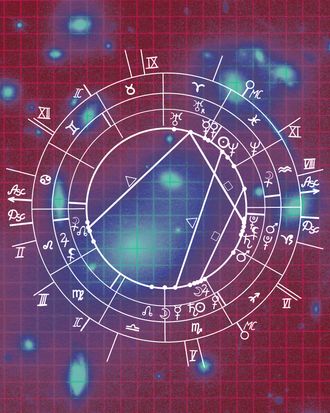
Ever wonder why certain celestial happenings are celebrated (like a particularly joyful solstice), while others prompt us to head for the hills (save us from Mercury retrograde!)? Well, my friend, it’s all about an extremely important aspect of astrology, which is — fittingly — called “Aspects.”
Technically, “aspects” refers to the angular relationships between celestial bodies. As the planets move across the 360-degree zodiac wheel, they meet each other through a variety of formations. When we calculate aspects, we can determine the relative position of planets across the sky, as well as within your birth chart, and illuminate the conversations that take place across these celestial bodies.
In creating astrological interpretations, planets are the “what” (what’s the story?), houses are the “where” (where in my life is this taking place?), and aspects are the “how” (how is this going to transpire?). Aspects are an extremely powerful tool: The connections between planets help us understand nuance, complexity, and the flow of energy. Through aspects, we can easily unpack meaning and glean invaluable insight as we’re able to pinpoint the precise opportunities and challenges associated with different events. Overwhelmed with what this all means? Deep breaths and keep reading.
How do aspects work?
In astrology, each planet is associated with a specific energetic force. As a quick refresher, the sun represents identity, the moon is emotions, Mercury is communication, Venus is values, Mars is motivation, Jupiter is expansion, Saturn is responsibilities, Uranus is innovation, Neptune is spirituality, and Pluto is transformation. So when multiple planets meet via aspects, we see what it looks like when different energies fuse. How does the sun mesh with Venus? What does it mean for Jupiter to sync with Saturn? What’s the vibe when the moon and Pluto come together?
Generally speaking, aspects are split into two main groups: “soft” aspects (connoting positive relationships between the planets) and “hard” aspects (connoting challenging planetary connections). There are dozens upon dozens of different angles — and accordingly, different aspects — that planets make with one another across the 360-degree zodiac wheel, but most modern astrologers focus work with the five “major aspects.”
Conjunctions (0 degrees)
When the planets meet at the exact same point in the sky, usually in the same zodiac sign and degree (which happens, for example, between the sun and moon during a new moon), the planetary energies blend together forming a powerful aspect known as a “conjunction.” This aspect is considered neither soft nor hard: Because the planets become a single entity, the impact of a conjunction hinges on which planets are involved. For example, a Mercury-Venus conjunction may help you communicate your values (Mercury symbolizes expression, and Venus is about worthiness, so the fused energies can help us articulate our desires), whereas a Mars-Pluto conjunction may lead to destructive behavior (Mars represents motivation, while Pluto is focused on intense metamorphosis, so the combination can be a bit aggressive).
Oppositions (180 degrees)
When planets meet at exact opposite positions in the sky, they form an opposition. A common example of a planetary opposition occurs during a full moon, when the sun and moon form an alignment across the zodiac (meaning they are on opposite sides of the actual sky). Traditionally, oppositions are considered hard aspects as the planets “face-off” with each other, generating tension and conflicting perspectives. While it’s true that oppositions can generate friction, this aspect can also be incredibly energizing. Because oppositions take place across the zodiacal axis, they’re fundamentally exposing two sides of the same coin. Accordingly, the stories generated through oppositions can be powerful conduits for change. Each zodiac sign has its mirror image — it’s exact opposite — so you can use the list below to discover which signs are always in opposition to one another.
- Aries and Libra
- Taurus and Scorpio
- Gemini and Sagittarius
- Cancer and Capricorn
- Leo and Aquarius
- Virgo and Pisces
Trines (120 degrees)
Trines are considered one of the most favorable aspects in astrology; they occur between planets that are approximately four zodiac signs apart (or 120 degrees), which is easy to identify in a birth chart (as opposed to a telescope) or in a daily chart wheel (a universal, up-to-the-date version of your birth chart). These planets are usually situated in the same element (fire, earth, air, or water), and — when they sync — create a gentle union distinguished by its ease and fluidity. These planets simply understand each other, and we can move forward easily with little external effort. But too much of anything — even auspicious trines — can lead to problems. On a bad day, trines can tend towards laziness and complacency. For example, when the moon and Venus trine, there’s a seamless flow between our wants and needs … though we may end up feeling like it’s our partner’s responsibility to do all the work and struggle with compromising or accommodating outside perspectives. This is because when the moon and Venus meet in the trine, the planets understand each other so intimately they don’t really see much room for improvement. Because trines occur between zodiac signs of the same element, you can use the below list to identify the zodiac signs that are always trining each other.
- Aries, Leo, Sagittarius (fire)
- Taurus, Virgo, Capricorn (earth)
- Gemini, Libra, Aquarius (air)
- Cancer, Scorpio, Pisces (water)
Squares (90 degrees)
Perhaps the most notorious aspect is the square, which occurs between planets approximately three zodiac signs apart (or form 90-degree angle in the sky from our vantage point). These planets are usually situated within the same modality (a way of categorizing the signs by how they express themselves): Cardinal signs (which occur at the beginning of each annual season), fixed signs (which take place in the middle), and mutable signs (which correspond with the end of each season). But they aren’t always considered to be particularly cooperative. Considered a hard aspect, squares create tension; intentions are divided, yielding emotional or logistical roadblocks. Despite the friction, however, squares always catalyze action. In fact, I consider squares to be the motion-oriented aspect — when squares occur, we can easily identify issues, empowering us to actually address the problem rather than sweep it under the rug. For example, when Mars (all about spontaneous motivation) and Saturn (all about rules and regulations) square, we may feel like our passions are always being dampened by our responsibilities. However, this aspect also creates an opportunity to slow down and become a true master at our craft — through refinement, hard work, and strategic planning, our desires are fueled by discipline. Because squares occur between zodiac signs of the same modality, you can use the below list to identify the zodiac signs that are always squaring each other.
- Aries squares Cancer and Capricorn
- Taurus squares Leo and Aquarius
- Gemini squares Virgo and Pisces
- Cancer squares Aries and Libra
- Leo squares Taurus and Scorpio
- Virgo squares Gemini and Sagittarius
- Libra squares Cancer and Capricorn
- Scorpio squares Leo and Aquarius
- Sagittarius squares Virgo and Pisces
- Capricorn squares Aries and Libra
- Aquarius squares Taurus and Scorpio
- Pisces squares Gemini and Sagittarius
Sextiles (60 degrees)
Finally, sextiles create a planetary buddy system. This aspect occurs between planets approximately two signs apart (or at a 60-degree angle away from each other in the sky). These planets are usually positioned in zodiac signs of the same polarity (fire and air are in one polarity; earth and water are in the other), and the energy is supportive and flowy. Because the planets aren’t in the same element (as they are in trines), there’s a bit more perspective with sextiles, which can deepen our understanding of complex situations. Considered a soft aspect, sextiles are thought to be friendly, conversational, and supportive. For example, when Mercury and Neptune are sextile, we may feel comfortable with personal artistic expression and feel inclined to foster environments where others can share their creative process, as well. This is because Mercury, which represents communication, is working harmoniously with ethereal Neptune, empowering otherwise abstract ideas to be articulated with ease and clarity. Because sextiles occur between zodiac signs of the same polarity, you can use the below list to identify the zodiac signs that sextile each other.
- Aries sextiles Gemini and Aquarius
- Taurus sextiles Cancer and Pisces
- Gemini sextiles Aries and Leo
- Cancer sextiles Taurus and Virgo
- Leo sextiles Gemini and Libra
- Virgo sextiles Cancer and Scorpio
- Libra sextiles Leo and Sagittarius
- Scorpio sextiles Virgo and Capricorn
- Sagittarius sextiles Libra and Aquarius
- Capricorn sextiles Scorpio and Pisces
- Aquarius sextiles Aries and Sagittarius
- Pisces sextiles Taurus and Capricorn
Aspects are such a critical component of astrology, as they illuminate not just what planets symbolize but how they actually work together. Every day, the entire solar system, with all of its planets and asteroids and mystical celestial bodies, come together in an elaborate cosmic waltz that we experience in our daily lives. Aspects add dimensions, depth, and a bit of spice to our astrological interpretations, so — whether you’re an astro-scholar or just getting started — don’t be afraid to roll up your sleeves and get into the weeds.
More astrology news and explainers
- Steel Yourself for Saturday’s Jupiter-Uranus Conjunction
- Get Ready for the Solar Eclipse in Aries to Change You
- A Guide to the Water Signs: Cancer, Scorpio, and Pisces





